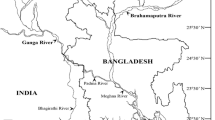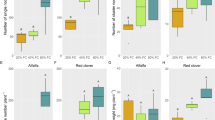Abstract
Schinus terebinthifolius Raddi (Schinus) is an invasive exotic species widely found in disturbed and native communities of Florida. This species has been shown to displace native species as well as alter community structure and function. The purpose of this study was to determine if the growth and gas exchange patterns of Schinus, under differing salinity conditions, were different from native species. Two native upland glycophytic species (Rapanea punctata and Randia aculeata) and two native mangrove species (Rhizophora mangle and Laguncularia racemosa) were compared with the exotic. Overall, the exotic’s morphologic changes and gas exchange patterns were most similar to R. mangle. Across treatments, increasing salinity decreased relative growth rate (RGR), leaf area ratio (LAR) and specific leaf area (SLA) but did not affect root/shoot ratios (R:S). Allocation patterns were however significantly different among species. The largest proportion of Schinus biomass was allocated to stems (47%), resulting in plants that were generally taller than the other species. Schinus also had the highest SLA and largest total leaf area of all species. This meant that the exotic, which was taller and had thinner leaves, was potentially able to maintain photosynthetic area comparable to native species. Schinus’ response patterns show that this exotic exhibits some physiological tolerance for saline conditions. Coupled with its biomass allocation patterns (more stem biomass and large area of thin leaves), the growth traits of this exotic potentially provide this species an advantage over native plants in terms of light acquisition in a brackish forested ecosystem.




Similar content being viewed by others
References
Allen JA, Chambers JL, Pezeshki SR (1997) Effects of salinity on baldcypress seedlings: physiological responses and their relation to salinity tolerance. Wetlands 17:310–320
Asch F, Dingkuhn M, Dorffling K (2000) Salinity increases CO2 assimilation but reduces growth in field-grown, irrigated rice. Plant Soil 218:1–10
Aspinall D (1986) Metabolic effects of water and salinity stress in relation to expansion of the leaf surface. Aust J Plant Physiol 13:59–73
Austin DF (1978) Exotic plants and their effects in southeastern Florida. Environ Conserv 5:25–34
Baker HG (1965) Characteristics and modes of origins of weeds. In: Baker HG, Stebbins CL (eds) The genetics of colonizing species. Academic, New York, pp 147–169
Baker HG (1986) Patterns of plant invasion in North America. In: Mooney HA, Drake JA (eds) Ecology of biological invasions of North America and Hawaii. Springer, New York Berlin Heidelberg, pp 44–57
Ball MC, Pidsley SM (1995) Growth responses to salinity in relation to distribution of two mangrove species, Sonneratia alba and S. lanceolata, in Northern Australia. Funct Ecol 9:77–85
Baruch Z, Goldstein G (1999) Leaf construction cost, nutrient concentration and net CO2 assimilation of native and invasive species in Hawaii. Oecologia 121:183–192
Bayuelo-Jiminez JS, Debouck DG, Lynch JP (2003) Growth, gas exchange, water relations, and ion composition of Phaeseolus species grown under saline conditions. Field Crops Res 80:207–222
Bright C (1998) Life out of bounds: bioinvasion in a borderless world. W.W. Norton, New York
Buchanan DL, Corcoran EJ (1959) Sealed tube combustions for the determination of 14C and carbon isotopes. Anal Chem 31:1635–1638
Busch DE, Smith SD (1995) Mechanisms associated with the decline of woody species in riparian ecosystems of the Southwestern US. Ecol Monogr 65:347–370
di Castri F (1989) History of biological invasions with species emphasis on the Old World. In: Drake JA, Mooney HA, di Castri F, Groves RH, Kruger FJ, Rejmanek M, Williamson M (eds) Biological invasions: a global perspective. Wiley, New York, pp 1–30
Cheeseman JM, Wickens LK (1986) Control of Na+ and K+ transport in Spergularia marina. III. Relationship between ion uptake and growth at moderate salinity. Physiol Plant 67:15–22
Cleverly JR, Smith SD, Sala A, Devitt DA (1997) Invasive capacity of Tamarix ramosissima in a Mojave Desert floodplain: the role of drought. Oecologia 111:12–18
Durand LZ, Goldstein G (2000) Photosynthesis, photoinhibition, and nitrogen use efficiency in native and invasive tree ferns in Hawaii. Oecologia 126:345–354
Doren RF, Whiteaker LD, Rochefort R (1991) Seasonal effects on herbicide basal bark treatement of Schinus terebinthifolius. In: Center TD (ed) Proceedings of the symposium on exotic pest plants: Nov 2–4, 1988. University of Miami, Rosenstiel School of Marine and Atmospheric Science, Miami, pp 115–129
Ewe SML (2001) Ecophysiology of Schinus terebinthifolius contrasted with native species in two South Florida ecosystems. PhD Dissertation, University of Miami, Miami
Ewe SML, Sternberg L da SL (2003) Seasonal gas exchange characteristics of Schinus terebinthifolius in a native and disturbed upland community in Everglades National Park, Florida. For Ecol Manage 179:27–36
Ewe SML, Sternberg L da SL. Water utilization patterns of the invasive exotic Schinus terebinthifolius and native species in two coastal plant communities. Journal of Coastal Research (accepted)
Ewe SML, Sternberg L da SL (in preparation) Seasonal gas exchange of the invasive exotic Schinus terebinthifolius versus coastal native plant species in Florida
Ewel JJ (1986) Invasibility: lesons from South Florida. In: Mooney HA, Drake JA (eds) Ecology of biological invasions of North America and Hawaii. Springer, New York Berlin Heidelberg, pp 214–230
Farquhar GD, O’Leary MH, Berry JA (1982) On the relationship between carbon isotope discrimination and the intercellular carbon dioxide concentration in leaves. Aust J Plant Physiol 9:121–137
Fung LE, Wang SS, Altman A, Hutterman A (1998) Effect of NaCl on growth, photosynthesis, ion and water relations of four poplar genotypes. For Ecol Manage 107:137–146
Khan MA, Aziz I (2001) Salinity tolerance of some mangroves from Pakistan. Wetland Ecol Manage 9:228–332
Kutsch WL, Kappen L (1991) Plasticity of the photosynthetic production of Galium aparine L. In: Esser G, Overdieck D (eds) Modern ecology. Elsevier, Amsterdam, pp 113–131
Lambers H, Poorter H (1992) Inherent variation in growth rate between higher plants: a search for physiological causes and ecological consequences. Adv Ecol Res 23:187–261
Lambers H, Chapin FS III, Pons TL (1998) Plant physiological ecology. Springer, New York Berlin Heidelberg
Lin G, Sternberg L da SL (1992) Effect of growth form, salinity, nutrient and sulfide on photosynthesis, carbon isotope discrimination and growth of red mangrove (Rhizophora mangle L.). Aust J Plant Physiol 19:509–517
Marcelis LFM, van Hooijdonk J (1999) Effect of salinity on growth, water use and nutrient use in radish (Raphanus sativus L.). Plant Soil 215:57–64
Munns R (1993) Physiological processes limiting plant growth in saline soils: some dogmas and hypotheses. Plant Cell Environ 16:15–24
Munns R, Termaat A (1986) Whole-plant responses to salinity. Aust J Plant Physiol 13:143–160
Mytinger LL (1985) The invasion of Schinus terebinthifolius into the saline communities of Everglades National Park. MSc Thesis. Louisiana State University, Baton Rouge
Naidoo G, von Willert DJ (1999) Gas exchange characteristics of the tropical mangrove, Pelliciera rhizophoraeae. Mangroves Salt Marshes 3:147–153
Naidoo G, Tuffers AV, von Willert DJ (2002) Changes in gas exchange and chlorophyll fluorescence characteristics of two mangroves and a mangrove associate in response to salinity in the natural environment. Trees 16:140–146
Nehrling H (1933) The plant world in Florida. McMillan, New York
Nilsen ET, Muller WH (1980a) A comparison of the relative naturalization ability of two “Schinus” species in southern California. I. Seed germination. Bull Torrey Bot Club 107:51–56
Nilsen ET, Muller WH (1980b) A comparison of the relative naturalizing ability of two “Schinus” species (Anacardiaceae) in southern California. II. Seedling establishment. Bull Torrey Bot Club 107:232–237
Pimentel D, Lach L, Zuniga R, Morrison D (2000) Environmental and economic costs of nonindigenous species in the United States. Bioscience 50:53–65
Plaut Z, Meinzer FC, Federman E (2000) Leaf development, transpiration and ion uptake and distribution in sugarcane cultivars grown under salinity. Plant Soil 218:59–69
Poorter H, Evans JR (1998) Photosynthetic nitrogen-use efficiency of species that differ inherently in specific leaf area. Oecologia 116:26–37
Reich PB (1993) Reconciling apparent discrepancies among studies relating life span, structure and function of leaves in contrasting plant life forms and climates—the blind men and the elephant retold. Funct Ecol 7:721–725
Schierenbeck KA, Marshall JD (1993) Seasonal and diurnal patterns of photsoynthetic gas exchange for Lonicera sempervirens and L. japonica (Caprifoliaceae). Am J Bot 80:1292–1299
Seemann J, Critchley C (1985) Effects of salt stress on the growth, ion content, stomatal behavior and photosynthetic capacity of a salt-sensitive species, Phaseolus vulgaris L. Planta 164:151–162
Simberloff D (1997) The biology of invasions. In: Simberloff D, Schmitz DC, Brown TC (eds) Strangers in paradise: impact and management of nonindigenous species in Florida. Island, Washington, pp 3–17
Sohan D, Jasoni R, Zajicek J (1999) Plant-water relations of NaCl and calcium-treated sunflower plants. Environ Exp Bot 42:105–111
Tuffers A, Naidoo G, von Willert DJ (2001) Low salinities adversely affect photosynthetic performance of the mangrove, Avicennia marina. Wetlands Ecol Manage 9:235–242
Vickery RK (1974) Growth in artificial climates—an indication of Mimulus’ ability to invade new habitats. Ecology 55:796–807
Warwick NWM, Bailey PCE (1997) The effect of increasing salinity on the growth and ion content of three non-halophytic wetland macrophytes. Aquat Bot 58:73–88
Acknowledgements
We thank Lee-Ann Hayek, Martin Buzas, the Wetland Ecosystem Ecology Laboratory at Florida International University and two anonymous reviewers for helpful comments on this manuscript. This research was in part supported by funding to Ewe from the Miami Horticultural Society, the University of Miami’s Biology Department (Curtis Award in Plant Biology) and the National Science Foundation through the Florida Coastal Everglades Long-term Ecological Research Program (DEB-9901514). This publication is contribution number 234 to Florida International University’s Southeast Environmental Research Center publication series and contribution number 654 to the Department of Biology, University of Miami’s Tropical Biology series.
Author information
Authors and Affiliations
Corresponding author
Rights and permissions
About this article
Cite this article
Ewe, S.M.L., da Silveira Lobo Sternberg, L. Growth and gas exchange responses of Brazilian pepper (Schinus terebinthifolius) and native South Florida species to salinity. Trees 19, 119–128 (2005). https://doi.org/10.1007/s00468-004-0370-7
Received:
Accepted:
Published:
Issue Date:
DOI: https://doi.org/10.1007/s00468-004-0370-7




